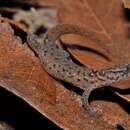en
names in breadcrumbs


Sphaerodactylus is a genus of geckos from the Americas[2] that are distinguished from other Gekkota by their small size, by their round, rather than vertical, eye pupils, and by each digit terminating in a single, round adhesive pad or scale, from which their name (Sphaero = round, dactylus = finger) is derived. All species in this genus are rather small, but two species, S. ariasae and S. parthenopion, are tiny, and – with a snout-vent length of about 1.6 cm (0.63 in) – the smallest reptiles in the world.[3]
Fossil remains referred to Sphaerodactylus have been recovered from Dominican amber.[4]
The following 108 species are recognized as being valid.[5]
Nota bene: A binomial authority in parentheses indicates that the species was originally described in a genus other than Sphaerodactylus.
Sphaerodactylus is a genus of geckos from the Americas that are distinguished from other Gekkota by their small size, by their round, rather than vertical, eye pupils, and by each digit terminating in a single, round adhesive pad or scale, from which their name (Sphaero = round, dactylus = finger) is derived. All species in this genus are rather small, but two species, S. ariasae and S. parthenopion, are tiny, and – with a snout-vent length of about 1.6 cm (0.63 in) – the smallest reptiles in the world.